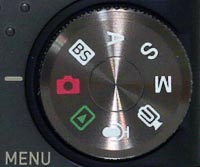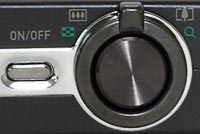Casio Exilim Pro EX-P700
Review Date: February 21st 2005
|
Ease of Use
The Casio Exilim Pro EX-P700 is a beautifully made digital camera that just about fits into the pocketable category of digicams, weighing 225g without the battery and storage card fitted. At first sight the EX-P700 looks a little unusual from the front, due to the plastic unit that houses the flash and speaker above the 4x optical zoom lens. In most other aspects of the design the EX-P700 is more conventional, reminding me of the Canon G series of cameras.
From the moment that you pick up the camera for the first time, you realize that the Casio Exilim Pro EX-P700 is an extremely well built camera - if only all digicams were like this one. The body is made of a hard-wearing dark brown/grey plastic composite which has a dull matt finish. The external controls, buttons and switches are all made of metal and feel very responsive. The design and implementation of the battery compartment cover, with its sliding cover and metal hinge, is typical of Casio's attention to detail. The EX-P700 is one of the best-made cameras that I have reviewed - full marks to Casio.
Coupled with the fantastic build quality, the Casio Exilim Pro EX-P700 also has a great feel to it. The camera is very well balanced, with my right thumb positioned exactly where the designers have added a grippy textured surface and my right forefinger ready to operate the shutter button and zoom lever on top of the camera body. The Casio Exilim Pro EX-P700 is one of those rare cameras that feels intuitive to handle and use from the start.
The EX-P700 has a large 2 inch LCD screen on the rear, which makes framing your images much easier than with smaller LCDs, with the added benefits of providing a menu system that has an easy-to-read large typeface. Larger LCD screens seem to be something of a growing trend at the moment. There is one drawback with the LCD screen, however, and that is the number of pixels - there are just 115,200 of them, which because the screen is so large results in the image being rather grainy. The effect isn't too noticeable, though, and the large size of the LCD more than compensates for it.
| Mode Dial | On/Off Button / Zoom Switch / Shutter Button |
 |
 |
The Casio EX-P700 is a feature-laden camera aimed at professional and keen amateur photographers, with a full range of manual and automatic controls. Thankfully Casio haven't tried to bury all the options in the menu system - instead they have made the more useful ones accessible by various dedicated buttons on the rear of the camera. So for example the BKT button accesses all of the bracketing and continuous shooting options (8 in total), and the AE-L button handily activates auto exposure lock. Casio have also dedicated a button to some of the more popular creative options - the EX button accesses the White Balance, ISO, Metering and AF area options. This is something that I have only seen before on certain Fujifilm digicams. Unlike the Fujifilm system, however, the same options are also available in the main menu system accessed via the Menu button.
There are 13 external controls in total on the Casio Exilim Pro EX-P700, with all of them clearly labeled and understandable. The shutter button is very large and tactile, positioned in the middle of the zoom lever on top of the camera. The zoom lever is very similar to the one found on the Canon G series of digicams. Using your right forefinger, you push it left to zoom the lens to wideangle, and pull it right to zoom it to telephoto. If you're used to the thumb-operated buttons found on many digicams, then this system may seem a little strange at first, but it soon becomes second-nature. All of the controls on the rear of the camera are well-sized, positioned and very well made. The only disappointing feature is the tripod mount which is positioned in the extreme left-hand corner of the bottom of the camera - the worst position possible. Thankfully the tripod mount is made of metal rather than plastic. Other than that I had no issues at all with the handling of this camera.
The menu system of the Casio Exilim Pro EX-P700 is as well designed as the exterior of the camera. It uses an intuitive tabbed interface with 3 pages at the top of the screen - REC, Memory and Set Up - and 6 options shown onscreen at one time. The only drawback with this system is that all the record options - things like image quality, white balance etc - are in the same REC menu, which makes it 4 pages/screens long (19 options in total). This can initially make it frustrating to find the option that you're looking for. On the plus side, the large LCD screen really makes a difference to using the menu system, as all the options are clearly displayed in a generously sized typeface.
The Casio Exilim Pro EX-P700 has a full range of manual and automatic modes, with aperture-priority, shutter-priority and full manual modes available. They are implemented in two different ways, and one of them is rather unusual. Instead of selecting the aperture or shutter speed via an external dial or button, as is the case with most cameras, you press the Set button and then use the left and right arrow buttons to set the value on a graphical sliding scale. For example, the left-most aperture value is f/2.8, and the right-most value is f/8.0. This system works well if the subject that you are trying to photography is static, as you have enough time to press the Set button, select your aperture/shutter speed, then press the shutter button. It doesn't work well with moving subjects, as the process just takes too long, and it doesn't work very well if you use the optical viewfinder in preference to the LCD screen, as you have to take your eye away from the viewfinder (which has no information displayed on it), set the value on the LCD screen, then recompose again. Thankfully you can also set aperture and shutter speed values by just pressing the left and right arrow buttons, which changes the aperture/shutter speed value shown on the main LCD screen display. This method is much quicker to use, although if you use the optical viewfinder you still have to look at the LCD screen to see the current value.
| Bracketing Button / Auto Exposure Lock Button / EX/Delete Button | Battery Compartment |
 |
 |
So what is the Casio Exilim Pro EX-P700 like to actually operate and take a photo? The start-up time from turning the camera on to being ready to take a photo is respectable enough at around 1.5 seconds. Zooming the 4x zoom lens from the widest focal length to the longest is not very quick, though, taking a leisurely 2 seconds, which doesn't make it particularly well-suited to tracking fast-moving subjects. Focusing is quick and responsive in good light and quite quick indoors and in low-light situations - a refreshing change from some digicams that I have reviewed recently which have really struggled indoors. It does take the Casio Exilim Pro EX-P700 quite a long time to format a memory card - approximately 40 seconds! Both the refresh rate and visibility of the 2-inch LCD screen are very good and it is visible even in bright sunlight. It takes less than 1/2 second to take and store an image in the normal shooting mode. There are also a range of continuous shooting modes that allow you to take up to 5 shots in less than 1 second by holding down the shutter button. Overall a snappy performance from the EX-Z55, with only the speed of the zooming mechanism and formatting a memory card slowing things down.
Once you have captured a photo, the Casio Exilim Pro EX-P700 has a lot of options when it comes to playing, reviewing and managing your images. You can scroll through the images that you have taken, zoom in and out to a factor of x4, and view thumbnail versions of each image. You can play a slideshow and configure the time and interval settings and save a photo as a Favourite image that you can then playback. You can configure which images you want to print, selecting whether to print the date and how many copies you want to print. You can crop an image using the trimming option, rotate and resize images, choose which images to Protect (to prevent them from being deleted), and delete an image. You can add sound to an image (called Dubbing), and even create an album of images, with 10 different layouts available. The Casio Exilim Pro EX-P700 even has a histogram feature, both before taking a photo or after, which makes evaluating the exposure of a photo much easier than by simply looking at it onscreen. Overall the Casio Exilim Pro EX-P700 has a multitude of playback options - the only missing ones that I can think of are effects like applying black and white or sepia filters.
The Casio Exilim Pro EX-P700 is a fantastically well-made and very easy to use digital camera with a multitude of beginner and more advanced features on offer. The only downsides are the slightly grainy LCD screen, poorly positioned tripod mount, slow-zooming lens and the 40 seconds that it takes to format a memory card. Apart from those small flies in the ointment, the EX-P700 is a joy to use.
|
 PhotographyBLOG is a member of the DIWA organisation. Our test results for the Casio Exilim Pro EX-P700 have been submitted to DIWA for comparison with test results for different samples of the same camera model supplied by other DIWA member sites.
PhotographyBLOG is a member of the DIWA organisation. Our test results for the Casio Exilim Pro EX-P700 have been submitted to DIWA for comparison with test results for different samples of the same camera model supplied by other DIWA member sites.
